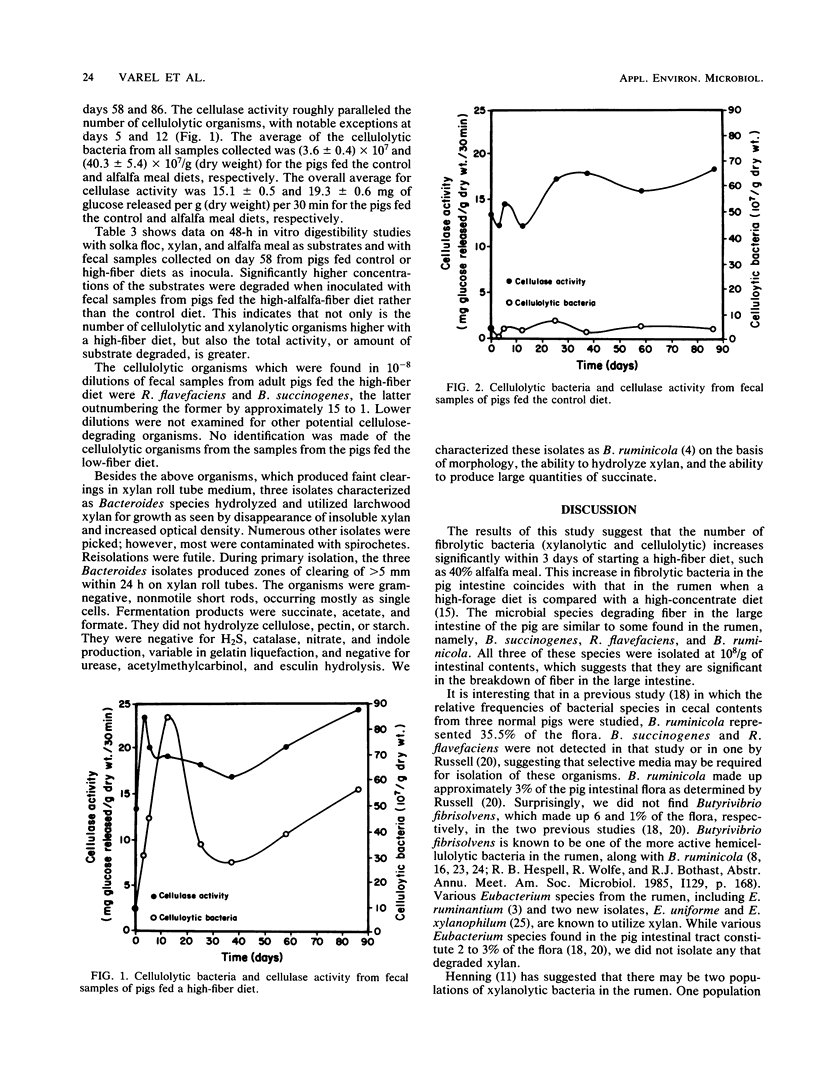Abstract
Xylanolytic and cellulolytic bacteria were enumerated over an 86-day period from fecal samples of 10 8-month-old gilts that were fed either a control or a 40% alfalfa meal (high-fiber) diet. Fecal samples were collected from all pigs on days 0, 3, 5, 12, 25, 37, 58, and 86. Overall, the numbers of xylanolytic bacteria producing greater than 5-mm-diameter zones of clearing on 0.24% xylan roll tube medium after 24 to 36 h of incubation were 1.6 X 10(8) and 4.2 X 10(8)/g (dry weight) of feces for the control pigs and those fed the high-fiber diet, respectively. After 1 week of incubation, a large number of smaller zones of clearing (1 to 2 mm) appeared. Besides Bacteroides succinogenes and Ruminococcus flavefaciens, which produced faint zones of clearing in xylan roll tubes, three strains which closely resembled B. ruminicola hydrolyzed and used xylan for growth. The overall numbers of cellulolytic bacteria producing zones of clearing in 0.5% agar roll tube medium were 0.36 X 10(8) and 4.1 X 10(8)/g for the control pigs and those fed the high-fiber diet, respectively. B. succinogenes was the predominant cellulolytic isolate from both groups of pigs, and R. flavefaciens was found in a ratio of approximately 1 to 15 with B. succinogenes. Degradation of xylan and cellulose, measured by in vitro dry matter disappearance after inoculation with fecal samples, was significantly greater for pigs fed the high-fiber diet than that for the controls. These data suggest that the number of fibrolytic microorganisms and their activity in the large intestine of the adult pig can be increased by feeding pigs high-alfalfa-fiber diets and that these organisms are similar to those found in the rumen.
Full text
PDF




Selected References
These references are in PubMed. This may not be the complete list of references from this article.
- BRYANT M. P. Bacterial species of the rumen. Bacteriol Rev. 1959 Sep;23(3):125–153. doi: 10.1128/br.23.3.125-153.1959. [DOI] [PMC free article] [PubMed] [Google Scholar]
- BRYANT M. P., SMALL N., BOUMA C., CHU H. Bacteroides ruminicola n. sp. and Succinimonas amylolytica; the new genus and species; species of succinic acid-producing anaerobic bacteria of the bovine rumen. J Bacteriol. 1958 Jul;76(1):15–23. doi: 10.1128/jb.76.1.15-23.1958. [DOI] [PMC free article] [PubMed] [Google Scholar]
- Betian H. G., Linehan B. A., Bryant M. P., Holdeman L. V. Isolation of a cellulotytic Bacteroides sp. from human feces. Appl Environ Microbiol. 1977 Apr;33(4):1009–1010. doi: 10.1128/aem.33.4.1009-1010.1977. [DOI] [PMC free article] [PubMed] [Google Scholar]
- Calvert C. C., Steele N. C., Rosebrough R. W. Digestibility of fiber components and reproductive performance of sows fed high levels of alfalfa meal. J Anim Sci. 1985 Sep;61(3):595–602. doi: 10.2527/jas1985.613595x. [DOI] [PubMed] [Google Scholar]
- Dehority B. A., Grubb J. A. Basal medium for the selective enumeration of rumen bacteria utilizing specific energy sources. Appl Environ Microbiol. 1976 Nov;32(5):703–710. doi: 10.1128/aem.32.5.703-710.1976. [DOI] [PMC free article] [PubMed] [Google Scholar]
- Dehority B. A. Hemicellulose degradation by rumen bacteria. Fed Proc. 1973 Jul;32(7):1819–1825. [PubMed] [Google Scholar]
- Henning P. A. Examination of methods for enumerating hemicellulose-utilizing bacteria in the rumen. Appl Environ Microbiol. 1979 Jul;38(1):13–17. doi: 10.1128/aem.38.1.13-17.1979. [DOI] [PMC free article] [PubMed] [Google Scholar]
- Holzgraefe D. P., Fahey G. C., Jr, Jensen A. H., Berger L. L. Effects of dietary alfalfa:orchardgrass hay and lasalocid on nutrient utilization by gravid sows. J Anim Sci. 1985 May;60(5):1247–1259. doi: 10.2527/jas1985.6051247x. [DOI] [PubMed] [Google Scholar]
- Imoto S., Namioka S. VFA production in the pig large intestine. J Anim Sci. 1978 Aug;47(2):467–478. doi: 10.2527/jas1978.472467x. [DOI] [PubMed] [Google Scholar]
- Leedle J. A., Bryant M. P., Hespell R. B. Diurnal variations in bacterial numbers and fluid parameters in ruminal contents of animals fed low- or high-forage diets. Appl Environ Microbiol. 1982 Aug;44(2):402–412. doi: 10.1128/aem.44.2.402-412.1982. [DOI] [PMC free article] [PubMed] [Google Scholar]
- Robinson I. M., Allison M. J., Bucklin J. A. Characterization of the cecal bacteria of normal pigs. Appl Environ Microbiol. 1981 Apr;41(4):950–955. doi: 10.1128/aem.41.4.950-955.1981. [DOI] [PMC free article] [PubMed] [Google Scholar]
- Robinson I. M., Whipp S. C., Bucklin J. A., Allison M. J. Characterization of predominant bacteria from the colons of normal and dysenteric pigs. Appl Environ Microbiol. 1984 Nov;48(5):964–969. doi: 10.1128/aem.48.5.964-969.1984. [DOI] [PMC free article] [PubMed] [Google Scholar]
- Russell E. G. Types and distribution of anaerobic bacteria in the large intestine of pigs. Appl Environ Microbiol. 1979 Feb;37(2):187–193. doi: 10.1128/aem.37.2.187-193.1979. [DOI] [PMC free article] [PubMed] [Google Scholar]
- Salyers A. A., Kuritza A. P., McCarthy R. E. Influence of dietary fiber on the intestinal environment. Proc Soc Exp Biol Med. 1985 Dec;180(3):415–421. doi: 10.3181/00379727-180-42198. [DOI] [PubMed] [Google Scholar]
- Varel V. H., Fryda S. J., Robinson I. M. Cellulolytic bacteria from pig large intestine. Appl Environ Microbiol. 1984 Jan;47(1):219–221. doi: 10.1128/aem.47.1.219-221.1984. [DOI] [PMC free article] [PubMed] [Google Scholar]
- Varel V. H., Pond W. G. Enumeration and activity of cellulolytic bacteria from gestating swine fed various levels of dietary fiber. Appl Environ Microbiol. 1985 Apr;49(4):858–862. doi: 10.1128/aem.49.4.858-862.1985. [DOI] [PMC free article] [PubMed] [Google Scholar]


